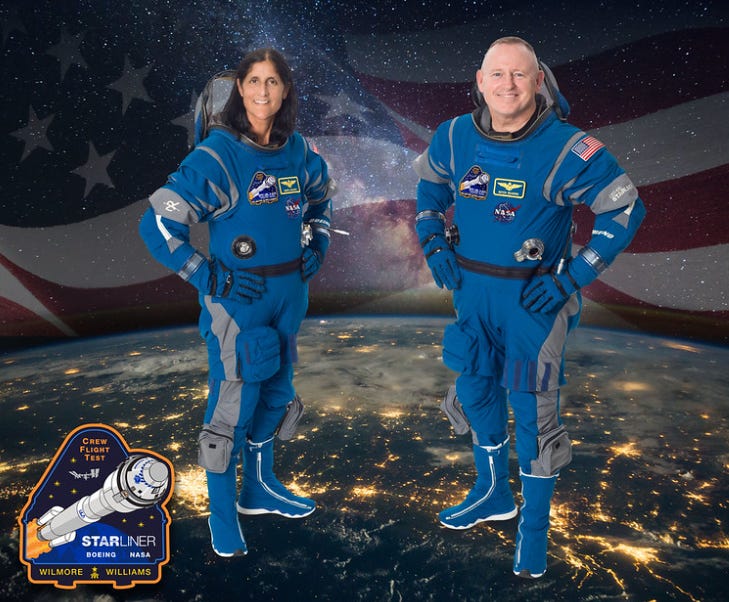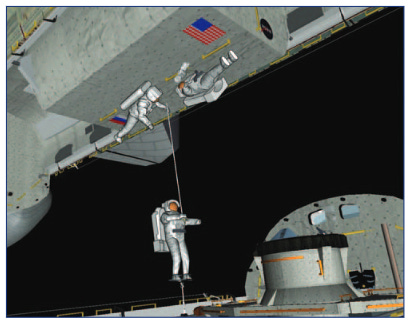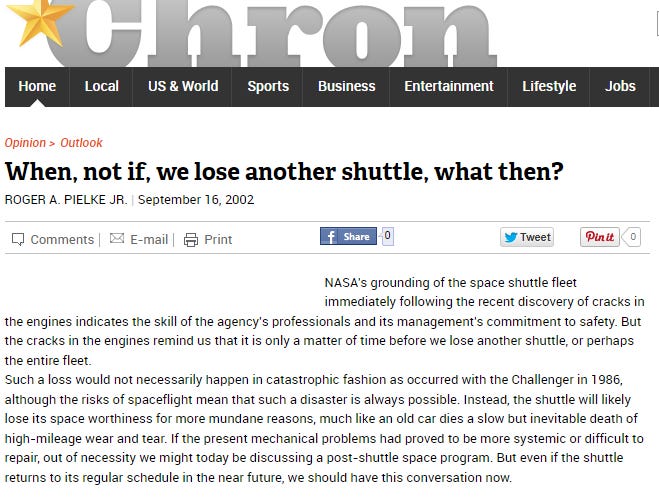
More than 30 years ago I wrote a master’s thesis that evaluated NASA’s Space Shuttle program (you can read the publications that followed here and here). As I turned to my PhD dissertation, I decided to move on from human space flight. Over the years that followed I felt like there was something left unfinished from my work on the Shuttle and that was to write publicly about the near certainty that NASA would inevitably lose another Shuttle, following the 1986 Challenger accident. This was not the result of any complex, technical analysis, just history and the binomial distribution.
So in September, 2002 — before blogs and long before Substack — I wrote an op-ed and sent it off to the Houston Chronicle, chosen because Johnson Space Center is in Houston.
The Chronicle published my op-ed in September 2002, where I argued, “inevitably, and perhaps soon, NASA and Congress will face difficult choices about the future of the space program.” Six months later, Space Shuttle Columbia broke apart on re-entry, resulting in the tragic loss of life of seven astronauts.
I have been thinking about Columbia a lot these past weeks as NASA has struggled with difficult decisions about what to do with two astronauts whose ride up to the station — the Boeing Starliner spacecraft — developed some technical problems. Is Starliner safe to bring the crew home? The mission was supposed to last only 8 days and is now well into its third month.
The Economist explains:
. . . Butch Wilmore and Suni Williams, [are] two astronauts who have been stranded on the International Space Station (ISS) since docking there on June 6th. Except NASA does not like that word. As one official insisted: “I want to make it very clear that Butch and Suni are not stranded in space.”
Mr Wilmore and Ms Williams arrived at the ISS aboard the first crewed flight of Boeing’s Starliner. What was meant to be an eight-day stay is approaching the three-month mark after their capsule leaked helium and five of its 28 thrusters malfunctioned. That has delayed their return, possibly until February 2025.
NASA has decided to bring the troubled Boeing Starliner capsule back to Earth empty and leave the astronauts on the station until a Space X mission can be readied early next year.
NASA’s current predicament has some things in common with the situation it found itself in with Columbia in 2002. As Columbia launched into space, just about 80 seconds after liftoff, NASA noticed that a piece of foam covering the big brown external fuel tank had broken off and hit the left wing of the shuttle. The only evidence was grainy footage taken from the perspective of the top of the orbiter, which did not allow any assessment of the consequences of the strike on the leading edge or the bottom.
NASA leadership decided that the impact posed little risk and Columbia returned, with tragic results.
Following the tragedy, the 2003 Columbia Accident Investigation Board found significant issues with NASA’s culture that led to an inability to properly handle risk, including an inability to deal with dissenting views:
Cultural traits and organizational practices detrimental to safety and reliability were allowed to develop, including: reliance on past success as a substitute for sound engineering practices (such as testing to understand why systems were not performing in accordance with requirements/specifications); organizational barriers which prevented effective communication of critical safety information and stifled professional differences of opinion; lack of integrated management across program elements; and the evolution of an informal chain of command and decision-making processes that operated outside the organization’s rules.
There can be little doubt that NASA has understood the lessons of Columbia and these lessons have shaped NASA’s decision making over the past few weeks. Specifically, in 2002 NASA had evidence suggesting that Columbia could be compromised in some way and chose not to take any action. Similarly, in 2024, NASA has evidence that Starliner has been compromised in some way, and has chosen to take action by eliminating the risks of deorbiting Wilmore and Williams in that capsule.
What is the best decision? That is impossible to say. According to media reports experts have different views on risks — a common situation where science meets politics. And the deorbiting decision has a lot of politics. Boeing has had a rough go of late, and Space X boosts the reputation of Elon Musk. There are new risks introduced by using Space X to bring back the astronauts and there are no guarantees in space flight.
In 2002, NASA’s only option for rescuing its crew on Columbia, had it chosen to do so, would have been Space Shuttle Atlantis, which was being prepared for a March 2003 launch to the international space station. That would have required an unprecedented short-term preparation for a launch and posed its own set of risks to the Columbia crew and the minimum of four astronauts needed on Atlantis. In 2024, space travel is different with multiple options available to reach orbit — A redundancy that reduces risks by providing options.

CNN and the BBC have produced an outstanding documentary on the Columbia accident. I embed the entire video below and highly recommend watching it. It is a remarkable case study in pathological organizational decision making and is exceedingly well done. Lots of new information and I learned a lot.
Best wishes to the astronauts getting home safely!
A new feature at THB: Live Chats. If you have a look at the header above, you’ll see a link titled “Chat.” A few times per week (at different times during the day, as THB has subscribers in every time zone around the world) I’ll show up in the Chat to engage with readers — on the latest THB posts, to ask me anything, and generally just to be available. For the next few weeks I’ll keep it open to everyone, and after that it’ll be just for paid subscribers. I hope to see you there! I am aiming for the next Live Chat to be tomorrow early AM Colorado time (~7AM MT).
Also, a reminder for paid subscribers: You have access to a whole bunch of good stuff at the THB Pro tab at the top. There you’ll find PDFs of three of my books and all posts and bonus content reserved for paid subscribers.
Honest brokering is a group effort, only possible because of your support.





"In 2002, NASA’s only option for rescuing its crew on Columbia, had it chosen to do so, would have been Space Shuttle Atlantis, which was being prepared for a March 2023 launch to the international space station. "
I think you mean March, 2003. And that would have been a daring rescue attempt if only NASA realized the danger that Columbia was in.
A redundancy that reduces should risks by providing options.
Should be:
A redundancy that reduces risks by providing options.